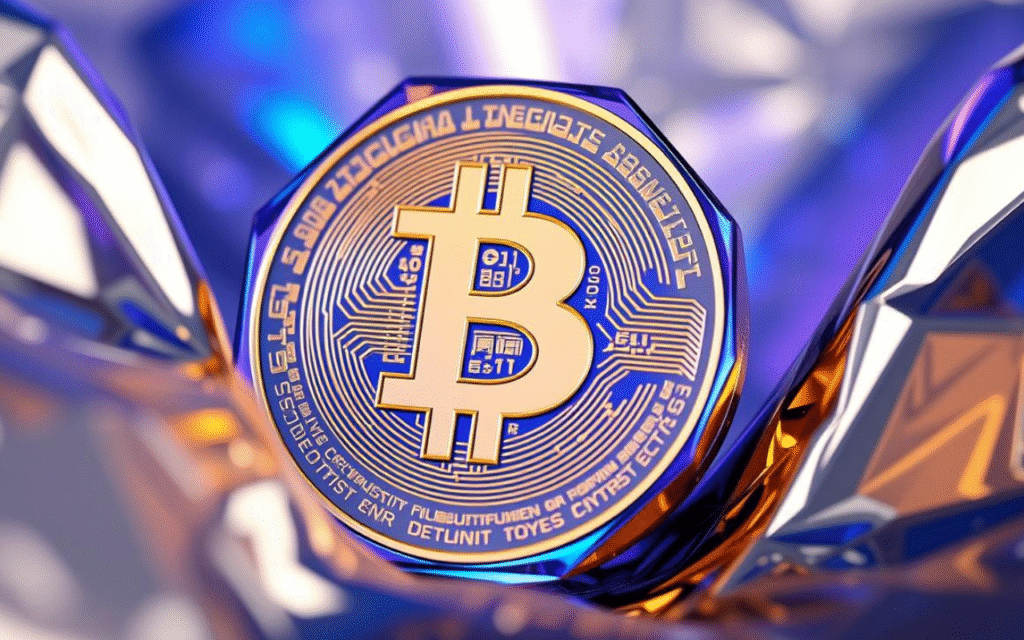The world of cryptocurrency is rapidly evolving, with new concepts and technologies emerging regularly. One such innovation is the concept of wrapped tokens, which has gained significant traction in the blockchain community.
Wrapped tokens are digital assets that represent another asset, allowing for the transfer of value between different blockchain networks. This innovation has opened up new possibilities for the use of cryptocurrencies in various financial applications, including lending, borrowing, and trading.
By enabling interoperability between different blockchain networks, wrapped tokens have become a crucial component of the decentralized finance (DeFi) ecosystem. Their significance lies in their ability to facilitate seamless interactions between disparate blockchain systems, thereby expanding the utility and potential of cryptocurrencies.

Key Takeaways
- Wrapped tokens represent another digital asset, enabling value transfer between blockchain networks.
- They facilitate interoperability between different blockchain systems.
- Wrapped tokens are crucial for the DeFi ecosystem, expanding cryptocurrency utility.
- They enable new financial applications, such as lending and borrowing.
- Wrapped tokens are a significant innovation in the cryptocurrency space.
Understanding Wrapped Tokens in Cryptocurrency
→ In the ever-evolving cryptocurrency ecosystem, wrapped tokens play a crucial role. They have emerged as a vital component, enabling the interaction between different blockchain networks.
1. Definition and Basic Concept
Wrapped tokens are digital assets that are pegged to the value of another asset, typically from a different blockchain. This is achieved by locking the original asset in a smart contract, thereby creating a wrapped version that can be used on another blockchain. For instance, Wrapped Bitcoin (WBTC) is a tokenized version of Bitcoin that operates on the Ethereum network.
2. How Wrapped Tokens Work
The process of creating wrapped tokens involves a custodian or a merchant who locks the original asset. A corresponding wrapped token is then minted and made available for use on the target blockchain. This process is reversible, when the wrapped token is returned and burned, the original asset is released. The table below illustrates the wrapping and unwrapping process:
| Step | Action | Result |
|---|---|---|
| 1 | Deposit Asset | Original asset locked |
| 2 | Mint Wrapped Token | Wrapped token created |
| 3 | Use Wrapped Token | Wrapped token utilized on target blockchain |
| 4 | Return Wrapped Token | Wrapped token burned |
| 5 | Release Original Asset | Original asset unlocked |
The Evolution of Wrapped Tokens in the Crypto Ecosystem
The concept of wrapped tokens has revolutionized the cryptocurrency landscape by enabling seamless interactions between different blockchain networks. This innovation has been pivotal in enhancing the overall functionality and interoperability of the crypto ecosystem.
1. Historical Development
Wrapped tokens originated as a solution to the problem of blockchain interoperability. The first wrapped tokens were introduced to facilitate the transfer of assets between Bitcoin and Ethereum, two of the largest blockchain networks. This development marked the beginning of a new era in cross-chain transactions.
2. Key Milestones in Wrapped Token Adoption
Several key milestones have driven the adoption of wrapped tokens. The introduction of Wrapped Bitcoin (WBTC) was a significant turning point, as it brought Bitcoin’s liquidity to the Ethereum network. Other notable developments include the expansion of wrapped tokens to other blockchain platforms and their increasing use in DeFi applications.
| Year | Milestone | Impact |
|---|---|---|
| 2019 | Introduction of WBTC | Bringing Bitcoin liquidity to Ethereum |
| 2020 | Expansion to other blockchain platforms | Increased interoperability |
| 2021 | Growing use in DeFi applications | Enhanced liquidity and capital efficiency |
[WBTC] The Flagship Wrapped Token
The rise of WBTC has been instrumental in bridging the gap between Bitcoin and Ethereum ecosystems. As a wrapped token, WBTC allows users to leverage the value of their Bitcoin on the Ethereum network, unlocking new possibilities in the DeFi space.
1. What Makes WBTC Special
WBTC stands out due to its robust security measures and the trust it has garnered within the cryptocurrency community. It is backed 1:1 by Bitcoin, ensuring that its value remains pegged to BTC. This backing, combined with its Ethereum-based infrastructure, makes WBTC an attractive asset for DeFi applications.
Key features of WBTC include:
- Reliable and secure wrapping process
- 1:1 backing by Bitcoin
- Seamless integration with Ethereum-based DeFi platforms
2. The WBTC Minting and Burning Process
The process of minting and burning WBTC is crucial to its operation. To mint WBTC, a user must first deposit Bitcoin with a merchant. The merchant then mints the equivalent amount of WBTC on the Ethereum network. Conversely, to redeem Bitcoin, a user burns WBTC, and the merchant releases the corresponding Bitcoin. This process ensures that WBTC remains fully backed by Bitcoin at all times.
→ This mechanism not only ensures the stability of WBTC but also fosters trust among its users.
Types of Wrapped Tokens and Their Applications
As the DeFi landscape expands, wrapped tokens have emerged as a crucial component, facilitating interoperability between different blockchain networks. This development has led to the creation of various types of wrapped tokens, each designed to serve specific purposes within the cryptocurrency ecosystem.
1. Ethereum-Based Wrapped Tokens
Ethereum-based wrapped tokens, such as Wrapped Ether (WETH) and Wrapped BNB (WBNB), have gained significant traction. WETH, for instance, is an ERC-20 compatible token that represents Ether on the Ethereum network, allowing it to be used in DeFi applications that require ERC-20 tokens. Similarly, WBNB wraps Binance Coin, making it compatible with Ethereum-based DeFi protocols.
These wrapped tokens enhance liquidity and facilitate trading on Ethereum-based decentralized exchanges (DEXs). They also enable users to participate in lending protocols and yield farming opportunities, further expanding the DeFi ecosystem.
2. Cross-Chain Wrapped Assets
Cross-chain wrapped assets take the concept of wrapped tokens a step further by enabling the use of assets from one blockchain on entirely different blockchain networks. This is achieved through complex wrapping mechanisms that ensure the original asset is collateralized while its wrapped version is used on another chain.
| Type of Wrapped Token | Blockchain | Primary Use |
|---|---|---|
| WETH | Ethereum | DeFi lending and trading |
| WBNB | Binance Smart Chain | Cross-chain DeFi applications |
The applications of wrapped tokens, whether Ethereum-based or cross-chain, are vast and continue to grow as the DeFi ecosystem evolves. They play a critical role in enhancing liquidity, facilitating cross-chain transactions, and expanding the overall functionality of blockchain networks.
How Wrapped Tokens Power DeFi Ecosystems
By bridging different blockchain networks, wrapped tokens have become a crucial component of the DeFi ecosystem. They facilitate the transfer of assets between different chains, thereby enhancing the overall functionality of DeFi applications.
1. Enhancing Liquidity and Capital Efficiency
Wrapped tokens significantly improve liquidity in DeFi markets by allowing assets from one blockchain to be utilized on another. For instance, WBTC (Wrapped Bitcoin) enables Bitcoin holders to participate in Ethereum-based DeFi protocols, thereby increasing capital efficiency. This interoperability allows users to access a broader range of financial services without needing to liquidate their assets.
Moreover, wrapped tokens help in reducing the fragmentation of liquidity across different blockchain networks. By creating a more unified market, they enable more efficient use of capital, benefiting both investors and DeFi protocols.
2. Enabling Cross-Chain Functionality
One of the key advantages of wrapped tokens is their ability to enable cross-chain functionality. This allows users to leverage the strengths of different blockchain networks, such as Ethereum’s robust DeFi ecosystem and Bitcoin’s secure store of value.
Wrapped tokens achieve this by creating a bridge between different chains, facilitating the transfer of assets and data. This not only enhances the user experience but also opens up new opportunities for DeFi innovation, as developers can now build applications that interact with multiple blockchain networks.
In conclusion, wrapped tokens are a vital component of the DeFi ecosystem, enhancing liquidity, improving capital efficiency, and enabling cross-chain functionality. As the DeFi space continues to evolve, the role of wrapped tokens is likely to become even more significant.

Benefits and Risks of Using Wrapped Tokens
As wrapped tokens continue to gain traction, it’s essential to examine the benefits and risks associated with their use in the crypto ecosystem. Wrapped tokens have become a crucial component of the cryptocurrency landscape, offering a bridge between different blockchain networks.
1. Advantages for Crypto Investors
Wrapped tokens offer several advantages to crypto investors. They enhance liquidity by allowing assets to be used across multiple blockchain platforms, thereby increasing their utility. Additionally, wrapped tokens facilitate cross-chain transactions, enabling investors to diversify their portfolios more efficiently. This interoperability can lead to greater capital efficiency, as assets are not limited to a single blockchain.
2. Custodial Risks and Technical Vulnerabilities
Despite the benefits, wrapped tokens also come with certain risks. One of the primary concerns is custodial risk, as the process of wrapping tokens often involves third-party custodians. If these custodians experience security breaches or mismanage assets, it can lead to significant losses. Furthermore, wrapped tokens are not immune to technical vulnerabilities. Smart contract risks and potential exploits in the wrapping and unwrapping processes pose additional threats to investors.
In conclusion, while wrapped tokens offer substantial benefits, including enhanced liquidity and cross-chain functionality, they also introduce custodial risks and technical vulnerabilities. Investors must carefully weigh these factors to make informed decisions in the evolving cryptocurrency market.
Conclusion [The Future of Wrapped Tokens in Crypto]
The world of cryptocurrency is constantly evolving, and wrapped tokens are playing an increasingly vital role in this ecosystem. As we’ve explored, wrapped tokens like WBTC are not only enhancing liquidity and capital efficiency in DeFi but also enabling cross-chain functionality.
As the crypto landscape continues to mature, the future of wrapped tokens looks promising. With their ability to bridge different blockchain networks, wrapped tokens are poised to drive further innovation in the DeFi space. This, in turn, is likely to attract more investors and users, fostering growth and adoption.
The wrapped tokens future is closely tied to the overall development of the crypto and DeFi sectors. As these markets expand, the demand for wrapped tokens is expected to rise, driving further advancements in this technology. Ultimately, wrapped tokens will remain a crucial component of the cryptocurrency ecosystem, facilitating greater interoperability and connectivity between different blockchain networks.


